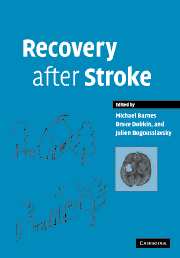Book contents
- Frontmatter
- Contents
- List of authors
- Preface
- 1 Stroke: background, epidemiology, etiology and avoiding recurrence
- 2 Principles of recovery after stroke
- 3 Regenerative ability in the central nervous system
- 4 Cerebral reorganization after sensorimotor stroke
- 5 Some personal lessons from imaging brain in recovery from stroke
- 6 Measurement in stroke: activity and quality of life
- 7 The impact of rehabilitation on stroke outcomes: what is the evidence?
- 8 Is early neurorehabilitation useful?
- 9 Community rehabilitation after stroke: is there no place like home?
- 10 Physical therapy
- 11 Abnormal movements after stroke
- 12 Spasticity and pain after stroke
- 13 Balance disorders and vertigo after stroke: assessment and rehabilitation
- 14 Management of dysphagia after stroke
- 15 Continence and stroke
- 16 Sex and relationships following stroke
- 17 Rehabilitation of visual disorders after stroke
- 18 Aphasia and dysarthria after stroke
- 19 Cognitive recovery after stroke
- 20 Stroke-related dementia
- 21 Depression and fatigue after stroke
- 22 Sleep disorders after stroke
- 23 Technology for recovery after stroke
- 24 Vocational rehabilitation
- 25 A patient's perspective
- Index
17 - Rehabilitation of visual disorders after stroke
Published online by Cambridge University Press: 05 August 2016
- Frontmatter
- Contents
- List of authors
- Preface
- 1 Stroke: background, epidemiology, etiology and avoiding recurrence
- 2 Principles of recovery after stroke
- 3 Regenerative ability in the central nervous system
- 4 Cerebral reorganization after sensorimotor stroke
- 5 Some personal lessons from imaging brain in recovery from stroke
- 6 Measurement in stroke: activity and quality of life
- 7 The impact of rehabilitation on stroke outcomes: what is the evidence?
- 8 Is early neurorehabilitation useful?
- 9 Community rehabilitation after stroke: is there no place like home?
- 10 Physical therapy
- 11 Abnormal movements after stroke
- 12 Spasticity and pain after stroke
- 13 Balance disorders and vertigo after stroke: assessment and rehabilitation
- 14 Management of dysphagia after stroke
- 15 Continence and stroke
- 16 Sex and relationships following stroke
- 17 Rehabilitation of visual disorders after stroke
- 18 Aphasia and dysarthria after stroke
- 19 Cognitive recovery after stroke
- 20 Stroke-related dementia
- 21 Depression and fatigue after stroke
- 22 Sleep disorders after stroke
- 23 Technology for recovery after stroke
- 24 Vocational rehabilitation
- 25 A patient's perspective
- Index
Summary
Introduction
Postchiasmatic brain lesions are reported in association with a variety of visual disorders after stroke, including cortical blindness, visual field disorders, achromatopsia, akinetopsia, visual agnosia, prosopagnosia, visuospatial neglect and Balint's syndrome (for review see Grüsser and Landis, 1991). This chapter is devoted to the rehabilitation of these syndromes in the context of acquired brain lesions in adults who had normal vision and normal visuocognitive performance prior to the stroke.
As much as two-thirds of the hemispheres is devoted to visual analysis (Zilles and Clarke, 1997) and, therefore, it is not surprising that 20–40% of patients with stroke have visual disorders (Hier et al., 1983). Visual disorders often have very debilitating effects in everyday life and specific techniques for their rehabilitation have been developed (Zihl, 2000), often based on the understanding of visual processing derived from recent work in humans or in non-human primates.
Neurobiological basis of visual perception
Experimental work since the early 1970s has changed radically our understanding of visual processing. Three issues are of great importance to visual rehabilitation. First, although visual information is relayed to the cortex primarily via the retinogeniculo–primary visual cortex route, alternative, smaller routes have been identified via the pulvinar or the superior colliculus. This is highly relevant to the understanding of preserved capacities in those with brain lesions, such as blindsight (Stoerig and Cowey, 1997) or interhemispheric transfer of visual information following callosotomy (Clarke et al., 2000). Second, the visual association cortex contains a large number of specialized visual areas. This was shown to be the case in non-human primates, where over 30 visual areas were identified (Felleman and van Essen, 1991). Activation studies indicate that human extrastriate visual cortex also contains functionally defined visual areas, some of which are highly specialized. This is the case for area V4, specialized for color perception (Zeki, 1990), and for area V5-MT, specialized for motion perception (Zeki, 1991). Selective deficits, such as achromatopsia or akinetopsia, are currently interpreted as the result of damage to these specialized areas. Third, the information flow within extrastriate visual cortex is directed along two streams: the ventral stream, subserving recognition and involving the inferior temporal cortex (the “What” stream), and the dorsal stream, subserving spatial aspects and involving the parietal cortex (the “Where” stream) (Mishkin et al., 1983).
- Type
- Chapter
- Information
- Recovery after Stroke , pp. 456 - 473Publisher: Cambridge University PressPrint publication year: 2005



